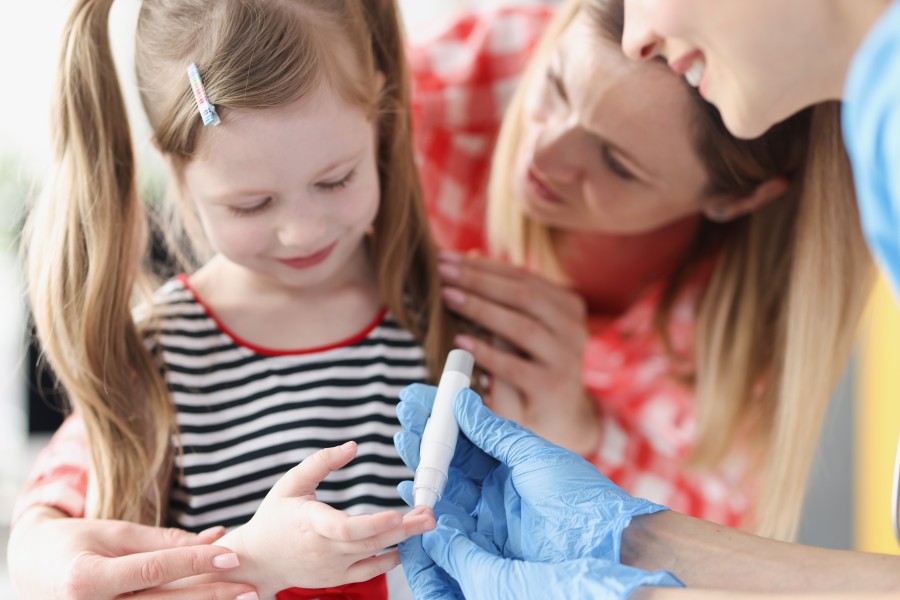Blood Glucose (Sugar) Levels In Children: What To Look For And When To Test

Blood Glucose (Sugar) Levels In Children: What To Look For And When To Test
Monitoring blood glucose (sugar) levels is an essential part of managing your child’s diabetes effectively. But if your child has diabetes, what should you be looking for, and what are the best ways of checking their blood glucose levels?
In this guide, we’re going to look at blood glucose levels in children — including the signs of high or low glucose levels, when you should be testing your child, and how to test. Read on to learn how to monitor blood glucose levels in children and more.
Why monitoring blood glucose levels in children is important
The number of children and young people living with diabetes is increasing every year. In 2019, there were over a million children and adolescents (up to 19 years old) with type 1 diabetes .
When your child has diabetes, it can be worrying and challenging for the entire family. However, with insulin therapy, careful blood glucose monitoring and support, they can live active, long and fulfilling lives.
Regular glucose checks are vital for children living with diabetes.
Children and adolescents (0–19 years of age) with type 1 or type 2 diabetes can develop all of the complications seen in adults with diabetes. If their blood glucose levels fall too low or become too high, they could develop health problems in the short term. They are also at risk of long-term diabetes complications, including cardiovascular, kidney and eye disease.
Monitoring your child’s glucose levels can help you actively manage their diabetes treatment, maintain their wellbeing and protect their future health.
Learning to monitor your child’s blood glucose levels
Regularly monitoring your child’s glucose levels at home will help you recognise blood glucose patterns — and their relation to factors such as food, exercise, stress, school and illness.
There are different ways to check your child's blood glucose levels so that you can adjust their insulin and achieve the best possible diabetes management.
This diabetes management needs to take into account your child’s age, needs and ability. For example, if your child is young, you will need to take the lead on monitoring their blood glucose levels and providing diabetes care. However, as they grow older, you, the diabetes care team and your child can work together to ensure they gradually become more skilled and confident in managing their condition.
Expected blood glucose levels in children
When your child has diabetes, their diabetes healthcare team will give them blood glucose targets to help them understand what blood glucose ranges they should be aiming for. Staying within these ranges will help to maintain their health and protect against diabetes complications.
Careful diabetes management is important, but it’s also vital to remember that your child’s health is not just about their data. Their glucose levels should always be considered as part of their wider health and wellbeing — taking social, emotional and physical factors into account. Your child’s diabetes healthcare team can help — for example, they can provide guidance to help you and your child maintain a balanced diet and learn how nutrition can affect their diabetes.
Signs of high blood glucose levels in children
High levels of blood glucose is called hyperglycaemia — also known as a ‘hyper' episode for short.
Your child’s diabetes team will set your child targets for their blood glucose level, but generally, hyperglycaemia is over 7 mmol/l before eating or more than 9 mmol/l after a meal.
The signs and symptoms of hyperglycaemia include:
- Feeling very thirsty
- Passing a lot of urine, going to the toilet more often and at night or having more wet nappies
- Feeling tired and weak
- Losing weight without trying
- Problems with vision
- Problems concentrating
- Nausea
- Abdominal pain
- Fruity smelling breath
If left untreated, a hyper can develop into a serious complication of diabetic ketoacidosis (DKA) [5]. Look out for:
- Nausea or vomiting
- Abdominal pain
- Dehydration
- Hyperventilation (difficulty breathing)
- Confusion
- Extreme drowsiness
- Reduced level of consciousness
- Sweet-smelling or fruity breath
If you are worried about DKA, seek urgent medical care.
Sign of low blood glucose levels in children
A low blood glucose level is known as hypoglycaemia. Episodes of hypoglycaemia are often called 'hypos' for short. During hypoglycaemia, the amount of glucose in your child’s blood drops too low.
It’s important to be aware of the signs of low blood glucose levels in your child and treat them quickly with a fast-acting source of glucose, such as a sweetened drink, glucose tablets or sweets because hypoglycaemia can become very dangerous.
Generally, a hypo is when your child's glucose is at or below 3.9 mmol/l. However, they may develop symptoms as their glucose falls and every child will have different low or high ranges.
The signs and symptoms of hypoglycaemia in children are:
- Increased hunger
- Headache
- Nausea
- Tiredness
- Cold, sweaty, pale, shaky and unwell
- Confused, difficulty concentrating
- Blurred vision
- Behavioural disturbances, including irritability and crying
- Nightmares and restless sleep
- Slurred speech
- Dizziness and unsteady on their feet
- Drowsy and difficult to rouse
- Decreased consciousness and in rare cases, coma
- Fits
However, symptoms can be subtle and differ between children. Always err on the side of caution and chat to their diabetes team so that you are confident in recognising and treating hypos.
How to monitor blood glucose levels in children
In children, blood glucose testing has traditionally included home-monitoring of glucose levels using capillary blood glucose tests, as well as regular blood tests to measure glycated haemoglobin (HbA1c).
However, continuous glucose monitors (CGM) are becoming more widely available, and can improve diabetes management, decrease worry, and reduce burden of care for some children living with diabetes.
Here are the three methods of monitoring blood glucose levels in children in more detail:
Using finger-prick tests to monitor glucose levels in children
Self-monitoring blood glucose levels (SMBG) allows you to measure your child’s glucose levels rapidly and accurately at home [4]. SMBG involves pricking your child’s finger using a lancet and using a glucose meter to measure their blood glucose level, in the same way an adult would test themselves [4,5, 9].
You will need to follow a structured testing programme — four or more tests a day are necessary for children with type 1 diabetes [4, 5]. It’s vital to test more frequently if they are exercising or unwell.
The National Institute for Health and Care Excellence (NICE UK) recommends these target ranges for optimal glucose management:
- Fasting plasma glucose (such as after waking in the morning): 4–7 mmol/litre
- Glucose level before meals: 4–7 mmol/litre
- Glucose level after meals: 5–9 mmol/litre
- Glucose level for young people when driving: At least 5 mmol/litre
Keeping the blood glucose levels towards the lower end of these ranges will help your child get the lowest possible HbA1c. However, this needs to be balanced against other factors, including the risk of their blood glucose becoming too low.
HbA1c testing
The HbA1c blood test gives a measure of your child’s average glucose over the previous two to three months. Healthcare professionals may want to test more frequently if your child is struggling to maintain their blood glucose levels.
The advised HbA1c target in the UK is typically 48 mmol/mol (or 6.5%) or lower [5,9] for most people, but a different target may be suggested for your child. Keeping their HbA1c as low as possible will help protect your child’s health and reduce their risk of getting diabetes complications.
However, your child’s diabetes team will set an HbA1c target for them, considering their activities, any other illnesses and their risk of hypoglycaemia. They will work with you to achieve this goal.
Continuous glucose monitoring (CGM)
Continuous glucose monitoring (also known as CGM) monitors your child's glucose levels day and night.
A small device is implanted, usually into their upper arm or abdomen, to read their glucose levels continuously. It uses a tiny sensor inserted under the skin to transfer information to a monitor, which can be read 24 hours a day so that you can see their glucose levels, spot patterns and identify highs and lows [9, 10]. Many devices will send warnings or alarms if they notice complications like hypoglycaemia [10].
Research shows that a CGM benefits the health and quality of life of children with diabetes and their families. These include: less pain and distress from finger-pricks, better diabetes control management, and less worry for parents or carers when the child is at school, with others, or asleep.
However, CGM isn’t for every child.
In research, some families have noted that their child was worried about insertion and removal, and parents themselves were concerned about accuracy and technical problems [8]. CGM’s can also be more expensive than traditional finger-prick testing, particularly if it isn't covered by insurance or healthcare.
Monitoring blood glucose levels in children can seem daunting if your child has just been diagnosed with diabetes — but with the help of your diabetes healthcare team, you can learn how to manage the condition together.
Source
- Danne T, Nimri R, Battelino T, Bergenstal RM, Close KL, DeVries JH, Garg S, Heinemann L, Hirsch I, Amiel SA, Beck R, Bosi E, Buckingham B, Cobelli C, Dassau E, Doyle FJ 3rd, Heller S, Hovorka R, Jia W, Jones T, Kordonouri O, Kovatchev B, Kowalski A, Laffel L, Maahs D, Murphy HR, Nørgaard K, Parkin CG, Renard E, Saboo B, Scharf M, Tamborlane WV, Weinzimer SA, Phillip M. International Consensus on Use of Continuous Glucose Monitoring. Diabetes Care. 2017 Dec;40(12):1631-1640. DOI: 10.2337/dc17-1600. PMID: 29162583; PMCID: PMC6467165. Available from: https://care.diabetesjournals.org/content/diacare/40/12/1631.full.pdf
- International Diabetes Federation. IDF Diabetes Atlas, 9th edn. Brussels, Belgium: 2019. Available at: https://www.diabetesatlas.org
- Los E, Wilt AS. Diabetes Mellitus Type 1 In Children. [Updated 2021 Aug 5]. In: StatPearls [Internet]. Treasure Island (FL): StatPearls Publishing; 2021 Jan-. Available on: https://www.ncbi.nlm.nih.gov/books/NBK441918/#_NBK441918_pubdet_
- Janet Silverstein, Georgeanna Klingensmith, Kenneth Copeland, Leslie Plotnick, Francine Kaufman, Lori Laffel, Larry Deeb, Margaret Grey, Barbara Anderson, Lea Ann Holzmeister, Nathaniel Clark. Care of Children and Adolescents With Type 1 Diabetes, Diabetes Care Jan 2005, 28 (1) 186-212; DOI: 10.2337/diacare.28.1.186 Available on: https://care.diabetesjournals.org/content/diacare/28/1/186.full.pdf
- NICE guideline: Diabetes (type 1 and type 2) in children and young people: diagnosis and management. Published: 1 August 2015 www.nice.org.uk/guidance/ng18
- Type 1 Diabetes High Blood Sugar Symptoms: Hyperglycemia Symptoms, JDRF. Last accessed 23/12/2021: https://www.jdrf.org/t1d-resources/about/symptoms/blood-sugar/high/
- Clarke W, Jones T, Rewers A, Dunger D, Klingensmith GJ. Assessment and management of hypoglycemia in children and adolescents with diabetes. Pediatric Diabetes 2009: 10 (Suppl. 12): 134–145. https://doi.org/10.1111/j.1399-5448.2009.00583.x Available on: https://onlinelibrary.wiley.com/doi/full/10.1111/j.1399-5448.2009.00583.x
- Karakuş KE, Sakarya S, Yeşiltepe Mutlu G, Berkkan M, Muradoğlu S, Can E, Gökçe T, Eviz E, Hatun Ş. Benefits and Drawbacks of Continuous Glucose Monitoring (CGM) Use in Young Children With Type 1 Diabetes: A Qualitative Study From a Country Where the CGM Is Not Reimbursed. J Patient Exp. 2021 Dec 2;8:23743735211056523. doi: 10.1177/23743735211056523. PMID: 34881352; PMCID: PMC8646182.
- NICE Guidelines: Having your blood glucose checked: HbA1c in Type 1 diabetes in adults: diagnosis and management [NG17]. Published August 2015: https://www.nice.org.uk/guidance/ng17/ifp/chapter/having-your-blood-glucose-checked-hba1c
- Mathew TK, Tadi P. Blood Glucose Monitoring. [Updated 2021 Aug 11]. In: StatPearls [Internet]. Treasure Island (FL): StatPearls Published; 2021 Jan-. Available on: https://www.ncbi.nlm.nih.gov/books/NBK555976/
- Tanenbaum ML, Zaharieva DP, Addala A, Ngo J, Prahalad P, Leverenz B, New C, Maahs DM, Hood KK. 'I was ready for it at the beginning': Parent experiences with early introduction of continuous glucose monitoring following their child's Type 1 diabetes diagnosis. Diabet Med. 2021 Aug;38(8):e14567. DOI: 10.1111/dme.14567. Epub 2021 Apr 21. PMID: 33772862; PMCID: PMC8480902. Available on: https://www.ncbi.nlm.nih.gov/pmc/articles/PMC8480902/





